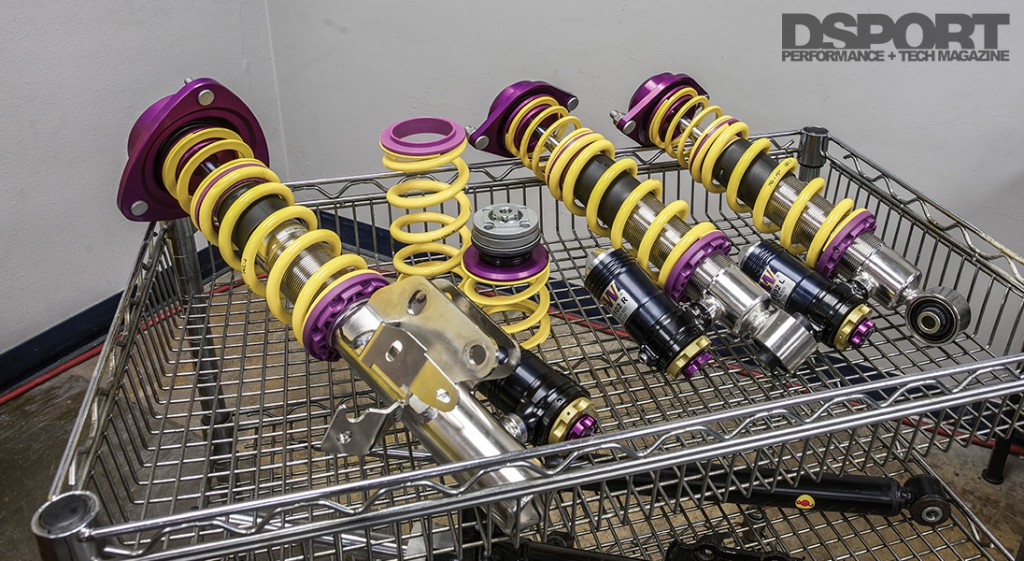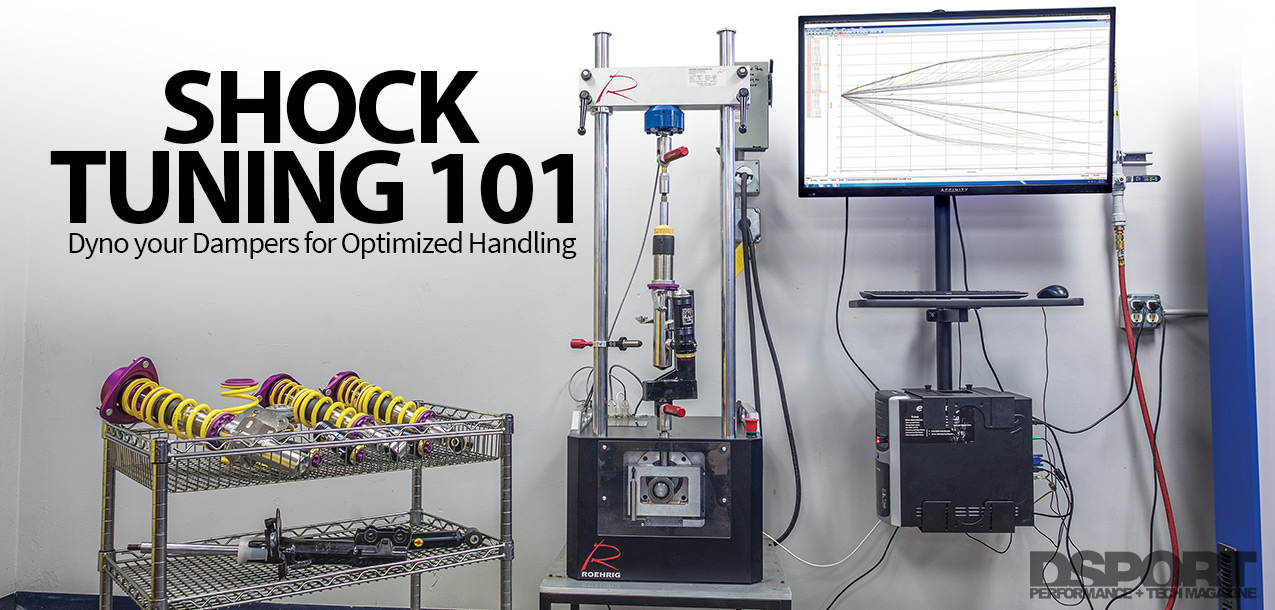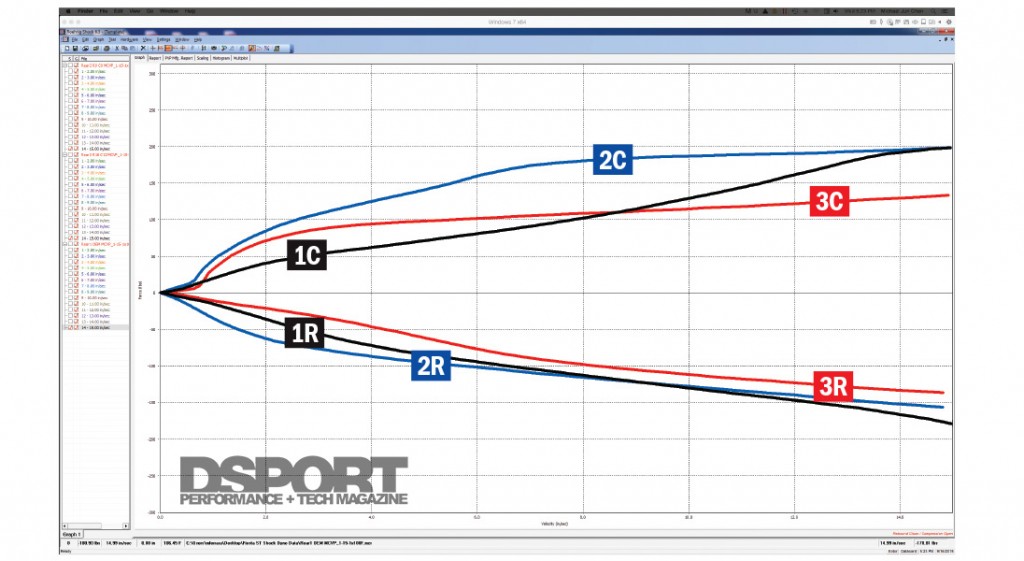Real World Numbers
To gain a better understanding of both the factory shocks and a set of aftermarket KW Variant 3 adjustable coilovers for our Project Fiesta ST, we ran a series of tests on a Roehrig Engineering 5VS dynamometer. We created a multi continuous velocity plot (CVP) test to assess the performance of the shocks. The multi CVP test collects data continuously throughout a complete cycle of compression and rebound. In the supplied SHOCK software, we first set up a temperature-based warmup to get the shocks up to 100-degrees Fahrenheit. This way, all the shocks would be tested at the same temperature for a fair comparison. Immediately following the warmup cycle, the dyno administered the test starting at a velocity of 1 inch/second then incrementally increasing to 15 inches/second by increments of 1 inch/second. We completed this test for the factory front and rear shocks as well as the front and rear KW Variant 3 shocks in various combinations of compression and rebound settings.
The resulting graphs of rebound and compression forces were not what we expected. Our original expectations put the factory shocks somewhere between the minimum and maximum force outputs of the aftermarket shocks. But the range of the factory front shocks surprised us. The factory front shock eclipsed the KW shock with both greater outputs of rebound and compression forces. With the KWs set for maximum rebound and compression then minimum rebound and compression, the results were in line with what we expected – the force outputs were greater at the maximum settings.
[pullquote]THE REAR SHOCKS DISPLAYED THE PERFORMANCE WE EXPECTED WITH THE EXCEPTION OF THEIR CHARACTERISTICS IN LOW VELOCITY VERSUS HIGH VELOCITY FORCE OUTPUT[/pullquote]The rear shocks displayed the performance we expected with the exception of their characteristics in low velocity versus high velocity force output. From 1 inch/second to approximately 9 inches/second, the factory rear shock made less compression force than the KW shock in both the minimum and maximum compression settings. In shock speeds faster than 9 inches/second, the factory shock surpassed the KW shock in the minimum compression setting and joined the KW shock’s force output by 14 inches/second. When comparing the compression force output of the KW shock when adjusted for minimum and maximum compression, the maximum compression setting displayed greater force throughout the curve than the minimum compression setting. Likewise, the same pattern was seen when observing the rebound settings in minimum and maximum adjustments. However, the factory shock rebound force curve was in between the two minimum and maximum curves from 1 inch/second to approximately 6.5 inches/second shock speeds. From 6.5 inches/second to approximately 10.5 inches/second, the factory shock matched the output of the KW shock set at maximum rebound. Beyond 10.5 inches/second, the factory shock produced slightly greater rebound forces.
Front Shocks
1C/1R
The 1C plot shows the compression force output of the factory shock, which until approximately 13.5 inches/second, was greater than the KW shocks. The 1R line displays the rebound force output of the factory shock.
2C/2R
The maximum compression (2C) and rebound (2R) force graphs of the KW shock indicated that the force output of the shock was between the factory shock and the minimum settings of the KW shocks.
3C/3R
The minimum compression and rebound settings of the KW shocks caused predictable changes to the output of the shock, with the entire plot generating lower compression (3C) and rebound (3R) force than the maximum setting.
Rear Shocks
1C/1C
The factory shocks output the least compression force in our testing for shock speeds up to approximately 9.0 inches/second but the rebound force was intermediate to the minimum and maximum rebound force of the KW shocks.
2C/2C
The maximum compression and rebound force outputs of the KW shocks were greater than the factory shocks throughout the graph which was tested up to 15.0 inches/second.
3C/3C
The minimum compression forces (3C) of the KW shocks were greater than the factory shocks until approximately 9.0 inches/second.
 Translations
Translations
What does this translate into in terms of applicable data? When investigating the front shocks, there is no way of setting the KW shocks to match the force output of the factory shocks. This may not be a bad thing; especially in cases like the excessive factory rebound force seen on the front shocks of the Fiesta ST. KW addressed this issue by purposely valving the front shocks to reduce the rebound force output over stock. The same is true for the compression phase of the front shocks when comparing the factory shocks to the KW Variant 3.
The rear KW shocks perform much more similar to the factory shocks. The KW shocks’ rebound adjustment can even be set to output less, the same, or more force than factory. In the compression phase of the rear shocks, comparison of the factory shocks to the KWs shows an increased output in force during low velocity in both the minimum and maximum settings. During high shock velocities (above 8.5 inches/second), the Variant 3s can be adjusted to match the factory compression force.
Knowing this information before heading to the track allowed us to adjust the shocks to our predicted desired settings, saving time and effort. We also were able to determine which settings yielded close-to-factory performance, which we used as a starting point for our suspension adjustments. Going forward we will be fine tuning the suspension of our Fiesta ST, stay tuned!



